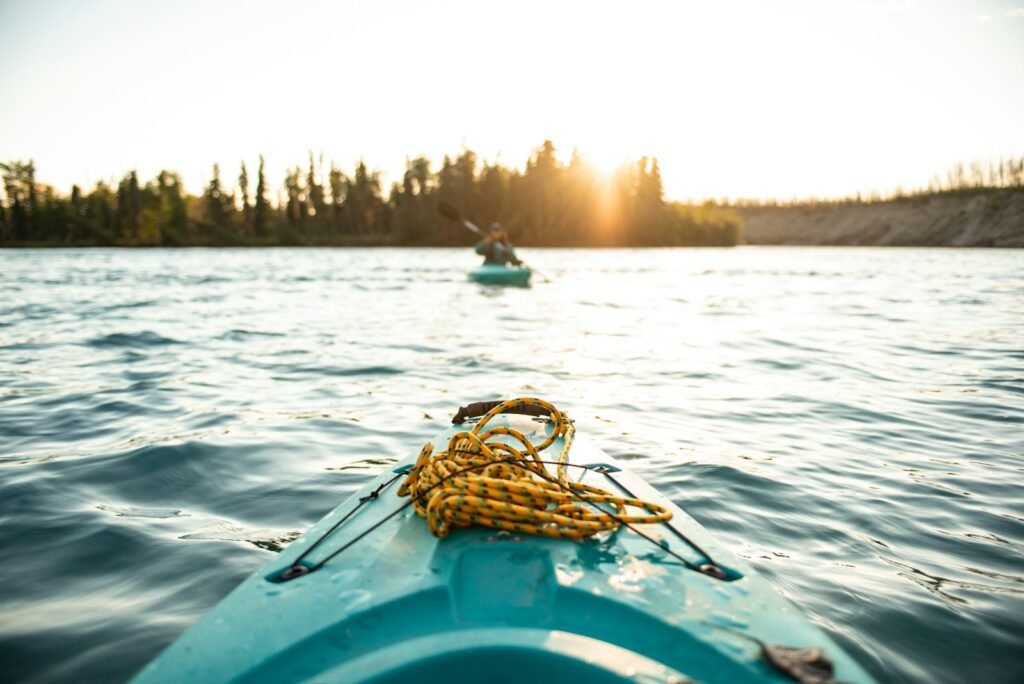Paddles at the ready, adrenaline pumping, the thrill of slicing through water – kayaking is an adventure like no other! But with all this excitement and outdoor beauty comes a question that nags at every novice paddler’s mind.
Is Kayaking dangerous? Well, like any sport or recreational activity, it can be. However, danger levels largely depend on your preparedness, understanding of safety protocols and respect for nature.
Intriguing isn’t it? As we navigate through this topic further ahead; expect to find valuable insights about risk factors in kayaking and how you can ensure a secure yet exhilarating experience on the water. Let’s paddle forward!

What Makes Kayaking a Risky Adventure?
Kayaking, despite its allure of pristine waters and the calming serenity of nature, carries inherent risks that make it a challenging adventure.
The thrill often comes hand in hand with danger, which can be attributed to certain factors such as unpredictable water conditions, weather unpredictability, inadequate preparation or lack of skills.
Let’s dig deeper into what makes kayaking an adventurous yet risky sport.
Dangerous Water Conditions
Paddling on serene lakes or raging rapids exposes kayakers to varying water conditions. Sudden shifts in current strength and direction can tip over the kayak.
Additionally, hidden underwater obstacles like sharp rocks or fallen tree branches pose significant dangers.
Weather Unpredictability
Kayakers are at the mercy of Mother Nature. Weather changes can be sudden and severe; sunny skies can quickly turn into stormy clouds leading to high winds and rough waters. This unpredictability adds an element of risk making every excursion a potential adventure.
Inadequate Preparation
Failing to prepare is preparing to fail – this saying holds true for kayaking adventures too. Inadequate planning regarding route selection, emergency procedures or failing to carry essential gear increases the chances of mishaps.
Lack Of Skills
Kayaking requires specific technical skills such as navigation techniques, capsizing recovery methods and understanding water dynamics. Lack of these skills considerably raises the risk factor during a kayaking trip.
How to Identify Potential Dangers in Kayaking?
Kayaking can be a thrilling activity, offering an excellent way to enjoy the outdoors. However, it also comes with potential dangers that should not be ignored.
Understanding these hazards and knowing how to deal with them is essential for every kayaker.
Weather Conditions:
One of the significant threats to kayakers is unfavorable weather conditions. Always check the forecast before heading out for your adventure. Storms, high winds, or sudden temperature drops can turn a fun outing into a dangerous situation quickly.
Rapid Currents:
Rivers might seem calm on the surface but could have swift currents underneath. These undercurrents are often invisible from above and can easily capsize a kayak if you’re not prepared.
Cold Water Immersion:
Falling into cold water may lead to hypothermia if you are not wearing proper gear or cannot get back into your kayak promptly. It’s crucial always to wear suitable clothing and know self-rescue techniques.
Ocean Tides & Waves:
If you plan on sea kayaking, understanding tides and waves becomes important as they can significantly affect your journey’s safety and ease.
Navigational Hazards:
These include submerged rocks or logs, low-head dams, bridge pilings among others which pose risk of collision leading potentially towards severe injuries or damage to your equipment.
Safety Measures to Mitigate Risks While Kayaking

Kayaking, while being a thrilling water sport, is not devoid of risks. However, with proper safety measures in place, these risks can be significantly reduced.
Ensuring personal safety and equipment readiness are paramount before you set sail on your adventure.
Let’s dig deeper into the various aspects of kayaking safety measures.
Personal Safety Preparations
Firstly, it’s important that every kayaker knows how to swim. Even though life jackets are mandatory while kayaking, knowing how to handle oneself in water adds an extra layer of security.
Physical fitness is another crucial aspect; ensure you have sufficient strength and stamina for the planned trip duration.
It’s also recommended to take a first aid course so you’re prepared for any medical emergencies that may arise during your adventure.
Equipment Readiness
Ensuring your kayak and other equipment are in top condition is vital for safe kayaking. Regularly inspect your gear for any damage or wear-and-tear before embarking on a trip.
Your list of essential equipment should include a well-fitted life jacket, helmet (especially if you plan on whitewater kayaking), spray skirt (for sea or whitewater kayaking), dry bag for essentials like food and first-aid kit, bilge pump or sponge to remove excess water from the kayak and paddle float for self-rescue situations.
Kayak Training And Navigation Skills
Having basic paddling skills will not only enhance your enjoyment but also add substantially to your safety.
Enroll yourself in beginner courses where professionals can guide you through techniques such as forward stroke, backward stroke and sweep stroke among others.
Navigation skills are equally important when out at sea or on large lakes where it’s easy to lose direction. Understanding charts and compass readings can prove extremely beneficial here.
Weather And Water Conditions
Checking weather forecasts before your trip is an absolute must. Avoid kayaking in severe weather conditions such as high winds or lightning storms.
Understanding water conditions is also crucial. Factors like current strength, water temperature and tide schedules should be taken into account while planning the trip.
Real-life Incidents of Kayaking Accidents
Kayaking, a popular water sport, has its share of risks and dangers. This section sheds light on some real incidents that highlight the potential perils of this seemingly serene activity. The purpose isn’t to scare but to increase awareness about safety measures while kayaking.
Drowning Incident in Colorado River
In 2019, a tragic incident occurred when an experienced kayaker drowned in the Colorado River.
Despite wearing all safety gear including a life jacket, he was trapped underwater after his kayak capsized due to strong currents.
It underscores the importance of understanding river conditions before venturing out.
Whitewater Kayak Accident in Norway
The extreme whitewater kayaking accident involving Shannon Christy is another example.
In 2013, she died during a practice run for Norway’s extreme race due to harsh rapids combined with high water levels.
Her death highlighted how even professionals can fall prey if they underestimate nature’s power.
Kayak Shark Attack off Maui Coast
A less common but serious danger is wildlife encounters while kayaking. A man fishing from his kayak off Maui coast became a victim of shark attack back in 2016 causing severe injuries which led to his unfortunate demise.
Who Should Avoid Kayaking and Why?
Kayaking is a thrilling water sport that offers numerous benefits, ranging from physical fitness to mental wellness. However, not everyone should engage in this activity due to various reasons.
Certain health conditions, fear of water and lack of swimming skills are among the main factors that can make kayaking unsuitable for some individuals.
Health Conditions
People with certain medical conditions might need to avoid kayaking. These include heart ailments, severe asthma or any other respiratory problems.
This is because kayaking requires considerable physical effort which can be strenuous for those with such health issues.
Fear of Water (Aquaphobia)
Individuals who have an intense fear of water or suffer from aquaphobia should steer clear of kayaking. This phobia can lead to panic attacks while on the kayak, creating dangerous situations.
Lack of Swimming Skills
While it’s not mandatory to be an expert swimmer for kayaking, basic swimming skills are essential for safety purposes. Those without these abilities may find themselves in perilous circumstances if their kayak capsizes.
Let’s dig deeper into each aspect:
- Medical Restrictions: It’s crucial for people with specific medical conditions like cardiovascular diseases or serious respiratory issues to refrain from high-energy activities like kayaking as they demand significant physical exertion.
- Aquaphobia: Kayakers often face waves and splashes; hence those suffering from aquaphobia may find this experience highly distressing leading them into panicky situations which are hazardous.
- No Swimming Skills: Non-swimmers should ideally avoid engaging in water sports including kayaking unless accompanied by an experienced guide. If the kayak tips over, non-swimmers could face life-threatening situations.
FAQs
What are the risks involved in kayaking?
Like any water-based activity, kayaking does come with some inherent risks. These can include capsizing, hypothermia due to cold water exposure, and collisions with other vessels or underwater objects.
Can I get injured while kayaking?
Yes, injuries can occur during a kayak outing. Common injuries from kayaking include strains and sprains from paddling or lifting the kayak, as well as more serious issues like head trauma if you capsize and hit your head.
Is it safe to go Kayaking alone?
Kayaking alone can be risky because there won’t be anyone nearby to help if something goes wrong. It’s generally safer to kayak with others or at least let someone know where you’re going and when you expect to return.
Does weather affect the danger level of kayaking?
Absolutely. Poor weather conditions such as high winds or storms can make waters choppy and difficult to navigate safely. Always check the weather forecast before setting out on a kayak trip.
